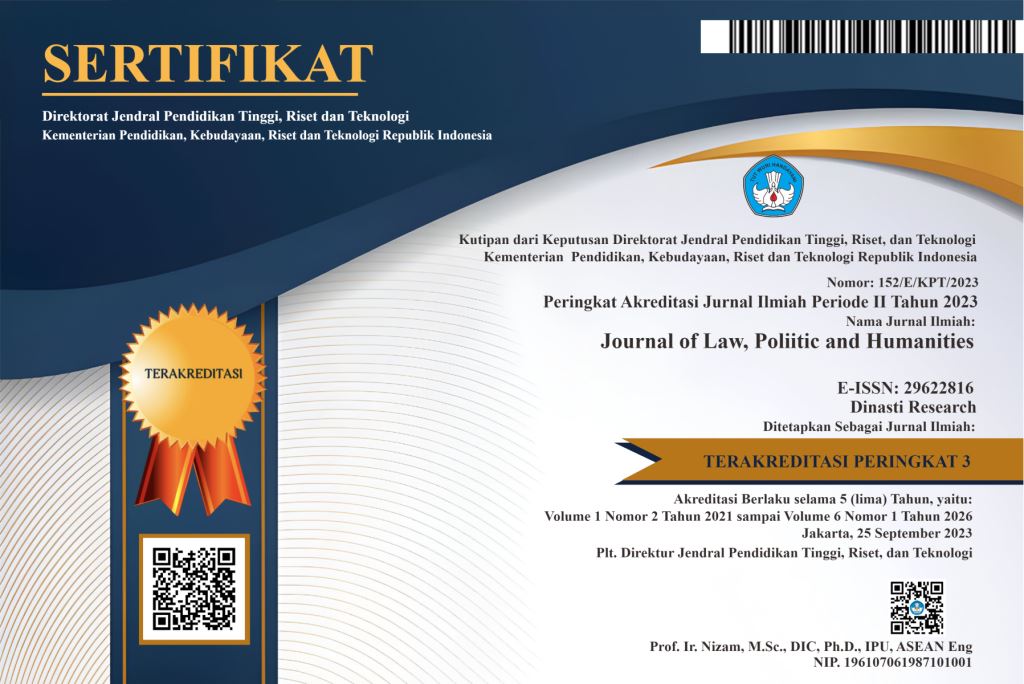Personal Data Protection Violations By Fintech Lending in Indonesia
DOI:
https://doi.org/10.38035/jlph.v4i4.414Keywords:
Personal Data, Fintech Lending, OJK, PDP AuthorityAbstract
The development of increasingly modern technology has changed the pattern of human behavior and work methods, which were initially conventional and then digitalized, one of which is marked by the presence of financial technology (fintech) lending. The rise of fintech lending development also has a negative impact, one of which is in terms of processing the personal data of fintech lending users. Hence, the Financial Services Authority formed POJK 10/2022. In connection with this, the PDP Law has also come into force in Indonesia. This paper aims to look at personal data protection violations by fintech lending, considering that two institutions have the authority to handle these violations. The method used is doctrinal legal research. The approach used is the statute approach. The results showed that to supervise fintech lending, it is necessary to classify its position first. If fintech lending is an LPBBTI organizer, it is supervised by OJK. Meanwhile, if fintech lending is the controller of personal data, it is supervised by the PDP Authority. As for reports or complaints of allegations and/or violations of personal data protection committed by fintech lending; examination and investigation of complaints of alleged violations of personal data protection; and imposition of administrative sanctions for violations of personal data protection by fintech lending are the authority of the PDP Authority, not OJK.
References
Dejan Jankovie. 2012. Key Security Measures for Personal Data Protection in IT Systems. Telecomunication Forum. 79-82.
Ernama Santi, Budiharto, dan Hendro Saptono. 2017. Pengawasan Otoritas Jasa Keuangan terhadap Financial Technology (Peraturan Otoritas Jasa Keuangan Nomor 77/POJK.01/206), Diponegoro Law Journal. 6:1-20.
Hendro Wijayanto, Dedy Hariyadi, dan Abdul Haris Muhammad. 2020. Analisis Penyalahgunaan Data Pribadi dalam Aplikasi Fintech Ilegal dengan Metode Hibrid. Jurnal Ilmiah Sinus. 18:1-10.
Ian Pollari Fin. 2016. The Rise of Fintech Opportunities and Challenges. Jassa The Finansie Journal of Applied Finance. 3:12-23.
M Rafifnafia Hertianto. 2021. Sistem Penegakan Hukum terhadap Kegagalan dalam Perlindungan Data Pribadi di Indonesia. Kertha Patrika. 43: 93-109.
P.T.J. Wolters. 2017. The security of personal data under the GDPR: A harmonized duty or a shared responsibility?. International Data Privacy Law. 7:165–178.
Roida Nababan dan Nelson Persada Sinaga. 2021. Perlindungan Hukum bagi Konsumen yang Data Pribadinya Diperjual Belikan di Aplikasi Fintech Peer-To-Peer Lending. Nommensen Journal of Legal Opinion. 02:156-167.
Winnie Stevani dan Lu Sudirman. 2021. Urgensi Perlindungan Data Pengguna Financial Technology terhadap Aksi Kejahatan Online di Indonesia. Journal of Judicial Review. 23:197-216.
Peter Mahmud Marzuki, Penelitian Hukum, Jakarta: Kencana, 2006.
Soerjono Soekanto, Pengantar Penelitian Hukum, Jakarta: Universitas Indonesia Press, 2008. Internet.
CNN Indonesia. 2020. Pakar: Data Nasabah KreditPlus Bocor Sejak Juli. https://www.cnnindonesia.com/teknologi/20200803182106-185-531749/pakar-data-nasabah-kreditplus-bocor-sejak-juli. Diakses pada 17 Maret 2024.
Kominfo RI. 2022. Teguh: Amanat UU, Presiden Tetapkan Lembaga Otoritas PDP. https://aptika.kominfo.go.id/2022/10/teguh-amanat-uu-presiden-tetapkan-lembaga-otoritas-pdp/. Diakses pada 21 Maret 2024. Novina Putri Bestari. 2022. Daftar Pinjol Ilegal Terbaru 2022, Jangan Sampai Terjerat. https://www.cnbcindonesia.com/tech/20220920063359-37-373396/daftar-pinjol-ilegal-terbaru-2022-jangan-sampai-terjerat. Diakses pada 21 Maret 2024
Downloads
Published
How to Cite
Issue
Section
License
Copyright (c) 2024 Nurul Insi Syahruddin, Eva Achjani Zulfa

This work is licensed under a Creative Commons Attribution 4.0 International License.
Authors who publish their manuscripts in this journal agree to the following conditions:
- The copyright on each article belongs to the author(s).
- The author acknowledges that the Journal of Law, Poliitic and Humanities (JLPH) has the right to be the first to publish with a Creative Commons Attribution 4.0 International license (Attribution 4.0 International (CC BY 4.0).
- Authors can submit articles separately, arrange for the non-exclusive distribution of manuscripts that have been published in this journal into other versions (e.g., sent to the author's institutional repository, publication into books, etc.), by acknowledging that the manuscript has been published for the first time in the Journal of Law, Poliitic and Humanities (JLPH).


























